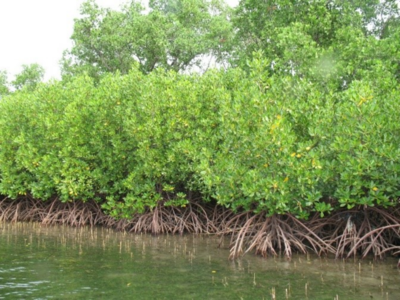- News
- City News
- bhubaneswar News
- Odisha: Genome sequencing of mangrove to help develop saline-tolerant crops
Odisha: Genome sequencing of mangrove to help develop saline-tolerant crops

Mangroves in Bhitarkanika (TOI Photo)
BHUBANESWAR: Mangrove, which is found in Bhitarkanika and some other parts of Odisha, besides Sundarbans in West Bengal and marshy intertidal estuarine regions of the country, can survive a high degree of salinity.
Amazed by this adaptive mechanism, scientists have conducted a thorough study on a mangrove species and found that its genes can help in developing drought and salinity-tolerant crops in future.
The research team comprising the Institute of Life Sciences (ILS), Bhubaneswar director Ajay Parida and M Parani’s group from the SRM Institute of Science and Technology, Tamil Nadu, has sequenced the genome of one of the highly salt- tolerant mangrove species — avicennia marina (gray mangrove, which in Odia is called Baani) — found in all mangrove habitats in the country.
This species grows optimally in 75% seawater and tolerates more than 250% seawater. It is capable of a rare phenomenon of excreting 40% of the salt through the salt glands in the leaves.
“We have sequenced nearly 99% of the genome of the species and aligned them to 31 chromosomes of the species. This is the first report of a high-quality genome assembly for any mangrove species reported so far,” Parida said.
The study has been published in the recent issue of Communications Biology (a Nature group of journals). It is a high-level genome assembly for the species because the researchers have conducted an assemblage of 456.6 mega base (Mb) out of the estimated 462.7 Mb marina genome (98.7% genome coverage) in 31 chromosomes.
Mb is the unit of length for DNA fragments.
The researchers have identified 31,477 protein-coding genes of this species.
“We have created a group of salinity-tolerant genes, namely salinome, comprising 3,246 salinity-responsive genes and characterised 614 of them for salinity tolerance. These genes can be used for developing salinity-tolerant crops,” Parida, who has been working on mangrove genetics and genomics for more than 25 years, said.
He added that the genome sequencing data of mangroves will immensely help researchers across the world in the future.
Agriculture productivity is affected globally owing to limited water availability and salinisation of soil and water.
Salinity is prevalent in roughly 900 million hectares globally (with an estimated 6.73 million ha in India). It causes an annual loss of 27 billion US dollars.
Sometimes saline water enters the farmland damaging the land and crop.
The genomic resources generated in the study will pave the way for researchers to study the potential of the identified genes for developing drought and salinity-tolerant varieties of important crop species of the coastal region, he added.
Mangroves work like a natural defence barrier to protect shorelines and provide habitat for a diverse array of terrestrial organisms. Many marine fish species solely depend on mangroves as their breeding, spawning, and hatching grounds.
Amazed by this adaptive mechanism, scientists have conducted a thorough study on a mangrove species and found that its genes can help in developing drought and salinity-tolerant crops in future.
The research team comprising the Institute of Life Sciences (ILS), Bhubaneswar director Ajay Parida and M Parani’s group from the SRM Institute of Science and Technology, Tamil Nadu, has sequenced the genome of one of the highly salt- tolerant mangrove species — avicennia marina (gray mangrove, which in Odia is called Baani) — found in all mangrove habitats in the country.
This species grows optimally in 75% seawater and tolerates more than 250% seawater. It is capable of a rare phenomenon of excreting 40% of the salt through the salt glands in the leaves.
“We have sequenced nearly 99% of the genome of the species and aligned them to 31 chromosomes of the species. This is the first report of a high-quality genome assembly for any mangrove species reported so far,” Parida said.
The study has been published in the recent issue of Communications Biology (a Nature group of journals). It is a high-level genome assembly for the species because the researchers have conducted an assemblage of 456.6 mega base (Mb) out of the estimated 462.7 Mb marina genome (98.7% genome coverage) in 31 chromosomes.
Mb is the unit of length for DNA fragments.
The researchers have identified 31,477 protein-coding genes of this species.
“We have created a group of salinity-tolerant genes, namely salinome, comprising 3,246 salinity-responsive genes and characterised 614 of them for salinity tolerance. These genes can be used for developing salinity-tolerant crops,” Parida, who has been working on mangrove genetics and genomics for more than 25 years, said.
He added that the genome sequencing data of mangroves will immensely help researchers across the world in the future.
Agriculture productivity is affected globally owing to limited water availability and salinisation of soil and water.
Salinity is prevalent in roughly 900 million hectares globally (with an estimated 6.73 million ha in India). It causes an annual loss of 27 billion US dollars.
Sometimes saline water enters the farmland damaging the land and crop.
The genomic resources generated in the study will pave the way for researchers to study the potential of the identified genes for developing drought and salinity-tolerant varieties of important crop species of the coastal region, he added.
Mangroves work like a natural defence barrier to protect shorelines and provide habitat for a diverse array of terrestrial organisms. Many marine fish species solely depend on mangroves as their breeding, spawning, and hatching grounds.
FacebookTwitterLinkedinEMail
Start a Conversation
end of article
Quick Links
Delhi Air PollutionDelhi TemperatureChennai WeatherBangalore TemperatureCovid vaccination centres in DelhiCoronavirus in DelhiRTPCR test in GurgaonHyderabad RainPollution level in BangaloreDelhi SmogDelhi TemperatureNoida AQIGurgaon AQI todayFire in MumbaiMumbai RainsCovid 19 RT PCR Test in NoidaDelhi AQI todaySrinagar encounter
